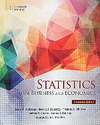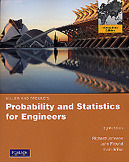Engineering Statistics, 5/e (SI Version)(IE-Paperback)
Douglas C. Montgomery , George C. Runger , Norma F. Hubele
- 出版商: Wiley
- 出版日期: 2011-11-01
- 定價: $1,780
- 售價: 9.5 折 $1,691
- 語言: 英文
- 頁數: 544
- ISBN: 0470646071
- ISBN-13: 9780470646076
-
相關分類:
機率統計學 Probability-and-statistics
下單後立即進貨 (約5~7天)
買這商品的人也買了...
-
 $3,325Pattern Recognition and Machine Learning (Hardcover)
$3,325Pattern Recognition and Machine Learning (Hardcover) -
 $1,715Introduction to Algorithms, 3/e (Hardcover)
$1,715Introduction to Algorithms, 3/e (Hardcover) -
 Web Design with HTML, CSS, JavaScript and jQuery Set (Paperback)
Web Design with HTML, CSS, JavaScript and jQuery Set (Paperback)$2,510$2,385 -
Principles of Physics: A Calculus Approach Volume 1, 2/e (Paperback)
$760$722 -
 Deep Learning (Hardcover)
Deep Learning (Hardcover)$1,650$1,617 -
 $1,323Cryptography and Network Security: Principles and Practice, 7/e (IE-Paperback)
$1,323Cryptography and Network Security: Principles and Practice, 7/e (IE-Paperback) -
 Computer Networking : A Top-Down Approach, 7/e (IE-Paperback)
Computer Networking : A Top-Down Approach, 7/e (IE-Paperback)$1,420$1,349 -
 Environmental Science, 15/e (Paperback)
Environmental Science, 15/e (Paperback)$1,280$1,254 -
 Fundamentals of Probability With Stochastic Processes, 4/e (Hardcover)
Fundamentals of Probability With Stochastic Processes, 4/e (Hardcover)$1,480$1,406 -
 Introduction to Mathematical Statistics, 8/e (GE-Paperback)
Introduction to Mathematical Statistics, 8/e (GE-Paperback)$1,460$1,387 -
 Calculus, 9/e (Metric Version)(Hardcover)
Calculus, 9/e (Metric Version)(Hardcover)$1,420$1,349
商品描述
Description
Montgomery, Runger, and Hubele provide modern coverage of engineering statistics, focusing on how statistical tools are integrated into the engineering problem-solving process. All major aspects of engineering statistics are covered, including descriptive statistics, probability and probability distributions, statistical test and confidence intervals for one and two samples, building regression models, designing and analyzing engineering experiments, and statistical process control. Developed with sponsorship from the National Science Foundation, this revision incorporates many insights from the authors' teaching experience along with feedback from numerous adopters of previous editions.
商品描述(中文翻譯)
描述
Montgomery、Runger和Hubele提供了現代工程統計學的涵蓋範圍,重點在於統計工具如何整合到工程問題解決過程中。涵蓋了工程統計學的所有主要方面,包括描述統計、概率和概率分佈、單樣本和雙樣本的統計檢驗和置信區間、建立回歸模型、設計和分析工程實驗以及統計過程控制。這個修訂版是在國家科學基金會的贊助下開發的,融入了作者的教學經驗以及之前版本的許多採用者的反饋意見。
目錄大綱
Table of contents
Chapter 1 The Role of Statistics in Engineering 1
1-1 The Engineering Method and Statistical Thinking 2
1-2 Collecting Engineering Data 6
1-2.1 Retrospective Study 7
1-2.2 Observational Study 8
1-2.3 Designed Experiments 9
1-2.4 Random Samples 12
1-3 Mechanistic and Empirical Models 15
1-4 Observing Processes Over Time 17
Chapter 2 Data Summary and Presentation 23
2-1 Data Summary and Display 24
2-2 Stem-and-Leaf Diagram 29
2-3 Histograms 34
2-4 Box Plot 39
2-5 Time Series Plots 41
2-6 Multivariate Data 46
Chapter 3 Random Variables and Probability Distributions 57
3-1 Introduction 58
3-2 Random Variables 60
3-3 Probability 62
3-4 Continuous Random Variables 66
3-4.1 Probability Density Function 66
3-4.2 Cumulative Distribution Function 68
3-4.3 Mean and Variance 70
3-5 Important Continuous Distributions 74
3-5.1 Normal Distribution 74
3-5.2 Lognormal Distribution 84
3-5.3 Gamma Distribution 86
3-5.4 Weibull Distribution 86
3-5.5 Beta Distribution 88
3-6 Probability Plots 92
3-6.1 Normal Probability Plots 92
3-6.2 Other Probability Plots 94
3-7 Discrete Random Variables 97
3-7.1 Probability Mass Function 97
3-7.2 Cumulative Distribution Function 98
3-7.3 Mean and Variance 99
3-8 Binomial Distribution 102
3-9 Poisson Process 109
3-9.1 Poisson Distribution 109
3-9.2 Exponential Distribution 113
3-10 Normal Approximation to the Binomial and Poisson Distributions 119
3-11 More than One Random Variable and Independence 123
3-11.1 Joint Distributions 123
3-11.2 Independence 124
3-12 Functions of Random Variables 129
3-12.1 Linear Functions of Independent Random Variables 130
3-12.2 Linear Functions of Random Variables That are Not Independent 131
3-12.3 Nonlinear Functions of Independent Random Variables 133
3-13 Random Samples, Statistics, and the Central Limit Theorem 136
Chapter 4 Decision Making for a Single Sample 148
4-1 Statistical Inference 149
4-2 Point Estimation 150
4-3 Hypothesis Testing 156
4-3.1 Statistical Hypotheses 156
4-3.2 Testing Statistical Hypotheses 158
4-3.3 P-Values in Hypothesis Testing 164
4-3.4 One-Sided and Two-Sided Hypotheses 166
4-3.5 General Procedure for Hypothesis Testing 167
4-4 Inference on the Mean of a Population, Variance Known 169
4-4.1 Hypothesis Testing on the Mean 169
4-4.2 Type II Error and Choice of Sample Size 173
4-4.3 Large-Sample Test 177
4-4.4 Some Practical Comments on Hypothesis Testing 177
4-4.5 Confidence Interval on the Mean 178
4-4.6 General Method for Deriving a Confidence Interval 184
4-5 Inference on the Mean of a Population, Variance Unknown 186
4-5.1 Hypothesis Testing on the Mean 187
4-5.2 Type II Error and Choice of Sample Size 193
4-5.3 Confidence Interval on the Mean 195
4-6 Inference on the Variance of a Normal Population 199
4-6.1 Hypothesis Testing on the Variance of a Normal Population 199
4-6.2 Confidence Interval on the Variance of a Normal Population 203
4-7 Inference on a Population Proportion 205
4-7.1 Hypothesis Testing on a Binomial Proportion 205
4-7.2 Type II Error and Choice of Sample Size 208
4-7.3 Confidence Interval on a Binomial Proportion 210
4-8 Other Interval Estimates for a Single Sample 216
4-8.1 Prediction Interval 216
4-8.2 Tolerance Intervals for a Normal Distribution 217
4-9 Summary Tables of Inference Procedures for a Single Sample 219
4-10 Testing for Goodness of Fit 219
Chapter 5 Decision Making for Two Samples 230
5-1 Introduction 231
5-2 Inference on the Means of Two Populations, Variances Known 232
5-2.1 Hypothesis Testing on the Difference in Means, Variances Known 233
5-2.2 Type II Error and Choice of Sample Size 234
5-2.3 Confidence Interval on the Difference in Means, Variances Known 235
5-3 Inference on the Means of Two Populations, Variances Unknown 239
5-3.1 Hypothesis Testing on the Difference in Means 239
5-3.2 Type II Error and Choice of Sample Size 246
5-3.3 Confidence Interval on the Difference in Means 247
5-4 The Paired t-Test 252
5-5 Inference on the Ratio of Variances of Two Normal Populations 259
5-5.1 Hypothesis Testing on the Ratio of Two Variances 259
5-5.2 Confidence Interval on the Ratio of Two Variances 263
5-6 Inference on Two Population Proportions 265
5-6.1 Hypothesis Testing on the Equality of Two Binomial Proportions 265
5-6.2 Type II Error and Choice of Sample Size 268
5-6.3 Confidence Interval on the Difference in Binomial Proportions 269
5-7 Summary Tables for Inference Procedures for Two Samples 271
5-8 What if We Have More than Two Samples? 272
5-8.1 Completely Randomized Experiment and Analysis of Variance 272
5-8.2 Randomized Complete Block Experiment 281
Chapter 6 Building Empirical Models 298
6-1 Introduction to Empirical Models 299
6-2 Simple Linear Regression 304
6-2.1 Least Squares Estimation 304
6-2.2 Testing Hypotheses in Simple Linear Regression 312
6-2.3 Confidence Intervals in Simple Linear Regression 315
6-2.4 Prediction of a Future Observation 318
6-2.5 Checking Model Adequacy 319
6-2.6 Correlation and Regression 322
6-3 Multiple Regression 326
6-3.1 Estimation of Parameters in Multiple Regression 326
6-3.2 Inferences in Multiple Regression 331
6-3.3 Checking Model Adequacy 336
6-4 Other Aspects of Regression 344
6-4.1 Polynomial Models 344
6-4.2 Categorical Regressors 346
6-4.3 Variable Selection Techniques 348
Chapter 7 Design of Engineering Experiments 360
7-1 The Strategy of Experimentation 361
7-2 Factorial Experiments 362
7-3 2k Factorial Design 365
7-3.1 22 Design 366
7-3.2 Statistical Analysis 368
7-3.3 Residual Analysis and Model Checking 374
7-3.4 2k Design for k ≥ 3 Factors 376
7-3.5 Single Replicate of a 2k Design 382
7-4 Center Points and Blocking in 2k Designs 390
7-4.1 Addition of Center Points 390
7-4.2 Blocking and Confounding 393
7-5 Fractional Replication of a 2k Design 398
7-5.1 One-Half Fraction of a 2k Design 398
7-5.2 Smaller Fractions: 2k-pFractional Factorial Designs 404
7-6 Response Surface Methods and Designs 414
7-6.1 Method of Steepest Ascent 416
7-6.2 Analysis of a Second-Order Response Surface 418
7-7 Factorial Experiments With More Than Two Levels 424
Chapter 8 Statistical Process Control 438
8-1 Quality Improvement and Statistical Process Control 439
8-2 Introduction to Control Charts 440
8-2.1 Basic Principles 440
8-2.2 Design of a Control Chart 444
8-2.3 Rational Subgroups 446
8-2.4 Analysis of Patterns on Control Charts 447
8-3 X̄ and R Control Charts 449
8-4 Control Charts For Individual Measurements 456
8-5 Process Capability 461
8-6 Attribute Control Charts 465
8-6.1 P Chart (Control Chart for Proportions) and nP Chart 465
8-6.2 U Chart (Control Chart for Average Number of Defects per Unit) and C Chart 467
8-7 Control Chart Performance 470
8-8 Measurement Systems Capability 473
Appendices 483
Appendix A Statistical Tables and Charts 485
Appendix B Bibliography 500
Appendix C* Answers to Selected Exercises 502
Index 511
目錄大綱(中文翻譯)
目錄
第一章 統計在工程中的角色 1
1-1 工程方法和統計思維 2
1-2 收集工程數據 6
1-2.1 回顧性研究 7
1-2.2 觀察性研究 8
1-2.3 設計實驗 9
1-2.4 隨機樣本 12
1-3 機械模型和經驗模型 15
1-4 隨時間觀察過程 17
第二章 數據摘要和展示 23
2-1 數據摘要和展示 24
2-2 莖葉圖 29
2-3 直方圖 34
2-4 盒狀圖 39
2-5 時間序列圖 41
2-6 多變量數據 46
第三章 隨機變量和概率分佈 57
3-1 引言 58
3-2 隨機變量 60
3-3 概率 62
3-4 連續隨機變量 66
3-4.1 概率密度函數 66
3-4.2 累積分佈函數 68
3-4.3 平均值和變異數 70
3-5 重要的連續分佈 74
3-5.1 正態分佈 74
3-5.2 對數正態分佈 84
3-5.3 伽瑪分佈 86
3-5.4 威布爾分佈 86
3-5.5 貝塔分佈 88
3-6 概率圖 92
3-6.1 正態概率圖 92
3-6.2 其他概率圖 94
3-7 離散隨機變量 97
3-7.1 概率質量函數 97
3-7.2 累積分佈函數 98
3-7.3 平均值和變異數 99
3-8 二項分佈 102
3-9 泊松過程 109
3-9.1 泊松分佈 109
3-9.2 指數分佈 113
3-10 對二項分佈和泊松分佈的正態近似 119
3-11 多個隨機變量和獨立性 123
3-11.1 聯合分佈 123
3-11.2 獨立性 124
3-12 隨機變量的函數 129
3-12.1 獨立隨機變量的線性函數 130
3-12.2 非獨立隨機變量的線性函數 131
3-12.3 獨立隨機變量的非線性函數 133
3-13 隨機樣本、統計量和中心極限定理 136
第四章 單一樣本的決策 148
4-1 統計推斷 149
4-2 點估計 150
4-3 假設檢驗 156
4-3.1 統計假設 156
4-3.2 假設檢驗 158
4-3.3 假設檢驗中的P值 164
4-3.4 單側和雙側假設 166
4-3.5 假設檢驗的一般程序 167
4-4 對已知變異數的母體均值的推斷 169
4-4.1 均值的假設檢驗 169
4-4.2 第二類錯誤和樣本大小的選擇 173
4-4.3 大樣本檢驗 177
4-4.4 對假設檢驗的一些實際評論 177
4-4.5 均值的置信區間 178
4-4.6 推導置信區間的一般方法 184
4-5 對未知變異數的母體均值的推斷 186
4-5.1 均值的假設檢驗 187
4-5.2 第二類錯誤和樣本大小的選擇 193
4-5.3 均值的置信區間 195
4-6 對正態母體的變異數的推斷 199
4-6.1 正態母體變異數的假設檢驗 199
4-6.2 正態母體變異數的置信區間 203
4-7 對母體比例的推斷 205
4-7.1 對二項比例的假設檢驗 205
4-7.2 第二類錯誤和樣本大小的選擇 208
4-7.3 二項比例的置信區間 210
4-8 其他區間估計```











